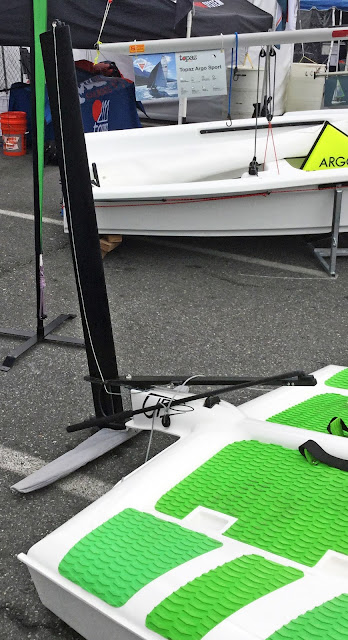Speaking of Steve Clark; he and his son David have been developing an easy-to-use foiler, the UFO, which is now in production from David's shop, Fulcrum Speedworks.
I was able to sneak into the Annapolis Spring Boat Show before it opened back in April and took some quick photos of the UFO. Unfortunately David wasn't around so I didn't have a conversation with him.
The UFO is a short catamaran configuration. One of the main components of a foiler's performance is the ability to keep everything light; cutting down on the surface area of the platform is one way to cut out weight. One must remember that the platform has no contribution to speed and exists to keep all the foiling bits, skipper, and rig tied together (and float everything when not foiling).
I gather the UFO has a low ride height setting for beginners (so that if you lose it the hulls won't come crashing down from up high) and a higher ride for the experts who want to go faster. Photos from the Internet show a weight tolerant package with several skippers over 90 kg (200 lbs) getting the UFO up and going.
I am no foiling expert so it would be best, if you are interested, to scan the Internet for further information.
A link to the UFO class website.
The main foil retracts between the two hulls so the UFO can be rigged upright, launched upright, and beached upright. The foils were designed by a French guru attached to Franck Cammas' foiling group.
There must be quite a bit of fancy composite engineering going on as both the high load main foil and high load mast step are situated back-to-back just at the front end of the forward beam.
Just enough clearance for the main foil to retract between the two hulls. The lime green non-skid gives some contrast to what is basically a white/black package (like most production small boats today).
The rudder and rudder foil sit off a short gantry, again another piece that needs to be engineered for cantilevered loading.
With this photo through the chain link fence, one can see the flat box hulls in the shape of the stern. The box shape of the hulls allow for the most displacement to be packed into a short length.
Looking good
1 day ago







4 comments:
We had one of these show up for the Sebago Cup cruising race for dinghies we have every year. The air was too light and the guy had just bought the boat and was still learning how to use it, so no actual foiling, but he'd made a conscious choice to bring this one instead of the Laser he was familiar with just as a learning thing. It was interesting seeing it!
Here it is on the water -
https://www.flickr.com/photos/93843138@N00/36342546653/in/album-72157686469200864/
Bonnie,
Yep, the problem with the foilers is; if they don't have enough wind to foil they are very ordinary sailboats, in fact less than ordinary since they have to drag all that extra foils through the water that aren't doing anything to help the boat go faster. If they have wind to foil, a very different story!
More and more companies are designing foilers to be able to take off in light air-5knots or so because the people that buy foilers don't want to be cut out of opportunities to fly.Great article and tremendous blog!!
douglord@cfl.rr.com
Post a Comment